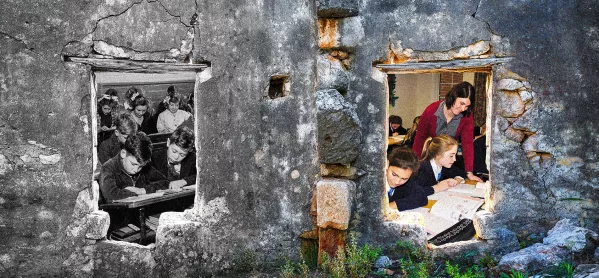While the risk of school building collapse from reinforced autoclaved aerated concrete (RAAC) has rocketed to the top of the agenda over the last few days, the situation has been brewing for 70 years.
In order to help understand the context behind why so many schools are now facing building closures, Tes has put together a timeline of how the risks from RAAC have suddenly come to the fore.
1950-1980
Thousands of schools are built using RAAC, which was seen as a wonder material at the time - one that offered a cheap, lightweight but robust way of constructing buildings, especially when used as planks to support flat roofs.
1999
A report from the Standing Committee on Structural Safety (SCOSS) urges those responsible for schools with pre-1980 RAAC-plank roofs to “arrange for these roofs to be inspected if this has not been done since 1994”.
However, it adds: “Generally, the deterioration of RAAC planks does not jeopardise structural safety.”
July 2018
The roof of Singlewell Primary in Gravesend, Kent collapses because of RAAC failing. Thankfully it occurred on a weekend when no one was present, but it revealed the stark reality of what can happen when RAAC fails.
December 2018
The Department for Education (DfE) and Local Government Association (LGA) make building owners aware of the above incident and risks from failing RAAC as recognition of the issue starts to grow.
May 2019
SCOSS issues an alert urging building owners to locate pre-1980 RAAC planks and assess their condition and structural safety. “Pre-1980 RAAC planks are now past their expected service life and it is recommended that consideration is given to their replacement,” it says.
March 2022
The DfE issues a questionnaire to responsible bodies for schools to determine the scale of RAAC across the school estate. As of May 2023, the National Audit Office (NAO) estimates as many as 8,600 schools identified as potentially containing RAAC in their buildings have yet to respond.
December 2022
The DfE lists the risk of school buildings collapsing as “very likely” and the issue is escalated to a group of top officials from across the government.
July 2023
The NAO releases a report stating the DfE has identified 572 schools that may contain RAAC. Of these, 196 had received assessments from surveyors with confirmation at 65 schools, 24 of which require immediate action
August 2023
Several schools identified as containing RAAC but believed to be safe suddenly suffer structural failures.
This forces the DfE to order 104 schools with identified RAAC to close buildings, just days before the new term starts. A further 52 are revealed to have already had mitigation work carried out.
The DfE also issues new guidance for schools on what to do if they have RAAC, or suspect they have it, in their setting.




